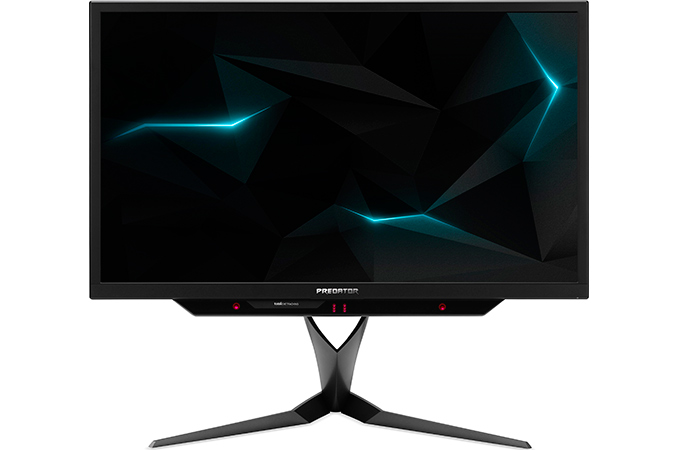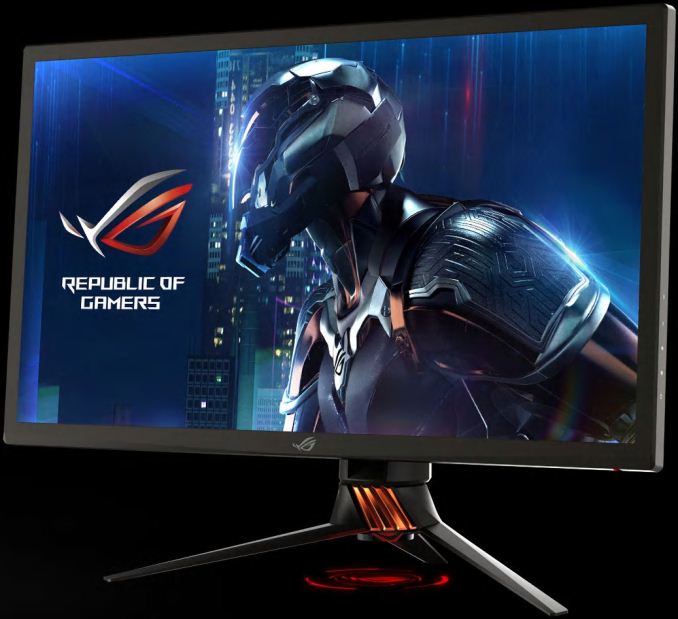Acer and ASUS G-Sync HDR Displays Listed & Priced In Europe
by Anton Shilov on April 10, 2018 3:00 PM EST- Posted in
- Monitors
- Acer
- Asus
- DCI-P3
- Predator X27
- ROG Swift PG27UQ
- G-Sync HDR

Select European retailers have begun to take pre-orders on G-Sync HDR-supporting monitors from Acer and ASUS that are expected to hit the market as early as late this month. Pricing of the Acer Predator X27 and the ASUS ROG Swift PG27UQ displays appears to be between €2500 and €3000 with VAT, which looks expensive even when European prices and VAT are taken into account.
Acer and ASUS first showcased their 27-inch 4K 144 Hz displays supporting NVIDIA’s G-Sync HDR technology at last year’s CES, but could not bring them to market in 2017. Last month NVIDIA — which developed and assembled the prototypes for these monitors — said that both highly-anticipated LCDs would ship in April to rejoice of gamers. However pricing for these monitors has never officially been unveiled, as Acer and ASUS were waiting until closer to the displays' launch to release that information.
According to Geizhals.eu, a price-search service, there are a number of retailers in Austria, Denmark and Germany, who are accepting pre-orders on the the Acer Predator X27 and the ASUS ROG Swift PG27UQ. The displays are expected to ship in late April, or in May, but their prices look rather extreme.
| G-Sync HDR Monitor Pre-Order Prices | ||||||
| Retailer | Local Price with VAT | Price in USD with VAT | Price in USD without VAT | |||
| Acer Predator X27 | Komplett.dk | 18,495 DKK | $3,068 | $2455 | ||
| ASUS ROG Swift PG27UQ | XITRA.de | €2,442 | $3,017 | $2535 | ||
| I-CS.at | €2,604 | $3,218 | $2682 | |||
| Built-Direkt.de | €2,646 | $3,270 | $2748 | |||
| K&M | €2,919 | $3,607 | $3031 | |||
| Bora Computers | €2,919 | $3,607 | $3031 | |||
The Acer Predator X27 and the ASUS ROG Swift PG27UQ monitors will be the first monitors to support NVIDIA’s G-Sync HDR technology, with their high-end technology setting them up to fetch a high-end price. From a hardware perspective, they are based on AU Optronics’ M270QAN02.2 AHVA panel featuring a 3840×2160 resolution and a 144 Hz refresh rate, this is a rare combination of features these days. Secondly, the monitors must support the DCI-P3 color gamut and a 1000 nits brightness, another challenging combination to be supported by the backlighting. Thirdly, these monitors feature a direct LED backlighting system with 384 zones, which is currently used on one professional monitor. Last but not least, the monitors need a new scaler that supports NVIDIA’s G-Sync HDR, which was developed by NVIDIA, which fetches a further premium.
Overall, initial pricing projections for the monitors had them at around $2000. These pre-order prices in Europe are higher still, but at the same time European hardware prices tend to run high even without the impact of VAT. So it remains to be seen where US pricing will end up. But regardless of the speciifc price tag, it looks like G-Sync HDR will remain a prerogative of ultra-premium LCDs and PCs for the time being.
Related Reading:
- NVIDIA Expects 4K 144 Hz G-Sync HDR Displays to Launch in April
- Acer and ASUS Delay Their 4K 144 Hz G-Sync HDR Displays to 2018
- ASUS Demonstrates ROG Swift PG27UQ: 4K, 144 Hz, HDR, DCI-P3 and G-Sync
- Acer Announces Predator X27 Monitor: 4K@144 Hz with DCI-P3, HDR10, & G-Sync
- Samsung Announces First Freesync 2 Monitors: CHG70 & CHG90 - Quantum Dots, Up to 49”, 144 Hz, DCI-P3
Sources: Geizhals.EU, TechPowerUp, TechReport











60 Comments
View All Comments
Sttm - Tuesday, April 10, 2018 - link
I could buy a 55 inch OLED for that! That is insane! A $1000 would have been reasonable, with standard non hdr Gysnc monitors at $700, but $2500... who is going to spend that!r3loaded - Tuesday, April 10, 2018 - link
Better yet, the 55 inch OLED TV doesn't look like Megatron either.iter - Tuesday, April 10, 2018 - link
The thought that there are people in the world that can produce or even worse - find such a design appealing makes me sad. And the pricing makes it that much worse...Hixbot - Tuesday, April 17, 2018 - link
Why does Asus think gaming components have to look like a toy spaceship?Alistair - Tuesday, April 10, 2018 - link
Why don't they make an HDR 1440p and save us a thousand dollars, right?Sttm - Tuesday, April 10, 2018 - link
I know right. Its not like you are going to be playing many games at 4k and 144 FPS.I also find 4k at 27 kind of terrible right now. 1440 is the perfect resolution for the windows desktop on a 27 inch screen, in terms of being able to actually read text natively. You'd have to run some scaling, and Windows scaling is very mediocre, especially when you have to do 125% or 150%.
Now if they had this at 5K, then maybe you could even argue the price was worth it. 200% percent scaling, retina display ppi heaven.
mode_13h - Wednesday, April 11, 2018 - link
I have a cynical take on this. The scaler is there so you can game with today's graphics cards, but Nvidia wants to be sure there's always room for improvement, so they can continue to sell ever higher-performing cards. This monitor is clearly screaming for twin Titan Xp's in SLI.Also, in regards to resolution vs. screen size, gamers will just dial down the AA. They achieve a similar effect (although I think I'd rather game at a slightly lower res with slightly better AA). And since dither is used to achieve 10-bit, a higher DPI means you'll see less of that noise.
Death666Angel - Wednesday, April 11, 2018 - link
Why would you ever want to game at a non-native resolution on an LCD? I always take the native res and reduce AA if I have anything on, I even reduce the texture quality to a point before going non-native with the resolution. Unless you are talking about integer value fractions of the max resolution. :)asgallant - Wednesday, April 11, 2018 - link
1440p may be the perfect resolution *for you* at 27", but it looks like a window screen to me. Scaling in Windows is fine now, with the exception of a few apps that are somehow written to ignore it (EA's Origin, I'm looking at you). I use 150% scaling on my 27" 4k displays when I work, and I'm a software engineer who spends all day staring at code. If the scaling sucked, my eyes would be bleeding from the strain of trying to read badly rendered text. Maybe its not as good as scaling on Macs? IDK, I'm not a Mac user.$2k is too much for these monitors though. Personally, I'd go for one without the G-sync hardware. The benefits of G-sync are practically zero* at 144hz anyway, why pay for the hardware for no benefit?
* the penalty for missing a frame update at 144hz is, at worst, ~7ms of stutter, which is too low for most people to detect, compared to ~17ms at 60hz. The benefit of G-sync is in eliminating most** of that penalty, so the smaller the penalty gets, the less you get from G-sync. As refresh rates rise, the benefits of G-sync asymptotically approach 0.
**G-sync introduces some small latency of its own. Best case is that it is not worse than the latency of the hardware it replaces in a non-G-sync version of the same monitor.
DanNeely - Tuesday, April 10, 2018 - link
because it's the 384 zone HDR backlight that's the stupidly expensive part, pairing it with a 144p display would only save a a hundred or so dollars. It would still be stupidly expensive, but much less premium. Eventually we will see the tech trickle down, but the backlights need to get significantly cheaper to make and/or the people willing to pay $2500 for a monitor need to buy enough of them to cover the initial R&D costs first.